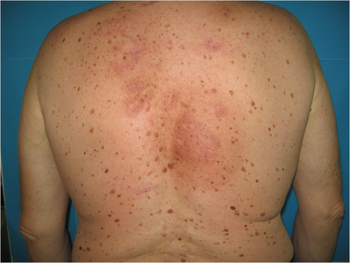Primary cutaneous follicle center lymphoma
| Primary cutaneous follicle center lymphoma | |
|---|---|
| Other names: PCFCL | |
 | |
| Post radiotherapy appearance | |
| Specialty | Hematology/oncology |
Primary cutaneous follicle center lymphoma is a type of lymphoma.[1] It was recognized as a distinct disease entity in the 2008 WHO classification.[2]: 218 PCFCL had been previously conceived as a variant of follicular lymphoma (FL).[2]: 218
Symptoms and signs
The clinical presentation for Primary cutaneous follicle center lymphoma is erythematous papules, plaques, and (or) tumors. This is usual on the trunk or forehead[3]
Cause
Unlike FL, PCFCL is not typically associated with t(14;18) translocation[2]: 218 although presence of that translocation does not exclude PCFCL.[2]: 314 It is usually not associated with overexpressed Bcl-2.[2]: 218
PCFCL represents about 55% to 60% of primary cutaneous B-cell lymphomas (PCBCL);[4]: 373 primary cutaneous marginal zone lymphoma and diffuse large B-cell cell lymphoma, leg type are the other primary cutaneous B-cell lymphomas.[4]: 373 [5][6] The cause of PCFCL is unknown.[2]: 312
Diagnosis
The diagnosis, per one review, indicates that immunohistochemistry and genetic test are appropriate[3]
Differential diagnosis
The DDx for Primary cutaneous follicle center lymphoma is the following:[3]
- Diffuse large B-cell lymphoma, leg type
- Follicular lymphoma
- Reactive lymphoid hyperplasia/pseudolymphoma
- Primary cutaneous marginal zone lymphoma
Treatment
Surgical removal and/or radiotherapy is given for localized disease.[2]: 314 [7] Radiation using multiple radiation fields is given if the disease has wider extent with grouped lesions.[2]: 314 [4][6][7] For the less common situation of more extensive disease (still confined to skin), rituximab without chemotherapy is used.[2]: 314 [4][6][7] Intralesional interferon alpha (IFN-α)[8] and intralesional rituximab have been used.[2]: 314 [8] Approximately one-third of PCFCL relapse, usually in the skin; treatment is similar to initial management[7] and overall survival remains excellent.[9]
Prognosis
Spread from the skin is unusual, and the prognosis is excellent[2]: 218 with a 5-year survival of over 97%.[2]: 314 The International Extranodal Lymphoma Study Group identified elevated LDH, more than two skin lesions, and nodular lesions as three prognostic factors, that are used to assess a cutaneous lymphoma international prognostic index (CLIPI), which is prognostic of disease-free status.[7]
See also
References
- ↑ Swerdlow, Steven H.; International Agency for Research on Cancer; World Health Organization (2008). WHO classification of tumours of haematopoietic and lymphoid tissues. World Health Organization classification of tumours. Vol. 2 (4th ed.). International Agency for Research on Cancer. ISBN 9789283224310. Archived from the original on 2015-02-11. Retrieved 2021-05-06.
- ↑ 2.00 2.01 2.02 2.03 2.04 2.05 2.06 2.07 2.08 2.09 2.10 2.11 Jaffe ES, Harris NL, Vardiman JW, Campo E, Arber, DA (2011). Hematopathology (1st ed.). Elsevier Saunders. ISBN 9780721600406.
- ↑ 3.0 3.1 3.2 Skala, Stephanie L.; Hristov, Boris; Hristov, Alexandra C. (November 2018). "Primary Cutaneous Follicle Center Lymphoma". Archives of Pathology & Laboratory Medicine. 142 (11): 1313–1321. doi:10.5858/arpa.2018-0215-RA. ISSN 1543-2165. Archived from the original on 23 September 2021. Retrieved 14 September 2021.
- ↑ 4.0 4.1 4.2 4.3 Armitage, JO; Mauch PM; Harris NL; et al. (2010). "Chapter 24". Non-Hodgkin Lymphomas (2nd ed.). Lippincott Williams & Wilkins. ISBN 9780781791168.
- ↑ Suárez AL, Pulitzer M, Horwitz S, et al. (2013). "Primary cutaneous B-cell lymphomas: part I. Clinical features, diagnosis, and classification". J. Am. Acad. Dermatol. 69 (3): 329.e1–13, quiz 341–2. doi:10.1016/j.jaad.2013.06.012. PMID 23957984.
- ↑ 6.0 6.1 6.2 Sokol L, Naghashpour M, Glass LF (2012). "Primary cutaneous B-cell lymphomas: recent advances in diagnosis and management". Cancer Control. 19 (3): 236–44. doi:10.1177/107327481201900308. PMID 22710899.
- ↑ 7.0 7.1 7.2 7.3 7.4 Wilcox RA (2015). "Cutaneous B-cell lymphomas: 2015 update on diagnosis, risk-stratification, and management" (PDF). Am. J. Hematol. 90 (1): 73–6. doi:10.1002/ajh.23863. PMID 25535037. S2CID 10733762. Archived from the original on 2021-09-23. Retrieved 2021-05-06.
- ↑ 8.0 8.1 Senff NJ, Noordijk EM, Kim YH, et al. (2008). "European Organization for Research and Treatment of Cancer and International Society for Cutaneous Lymphoma consensus recommendations for the management of cutaneous B-cell lymphomas". Blood. 112 (5): 1600–9. doi:10.1182/blood-2008-04-152850. PMID 18567836.
- ↑ Suárez AL, Querfeld C, Horwitz S, et al. (2013). "Primary cutaneous B-cell lymphomas: part II. Therapy and future directions". J. Am. Acad. Dermatol. 69 (3): 343.e1–11, quiz 355–6. doi:10.1016/j.jaad.2013.06.011. PMID 23957985.